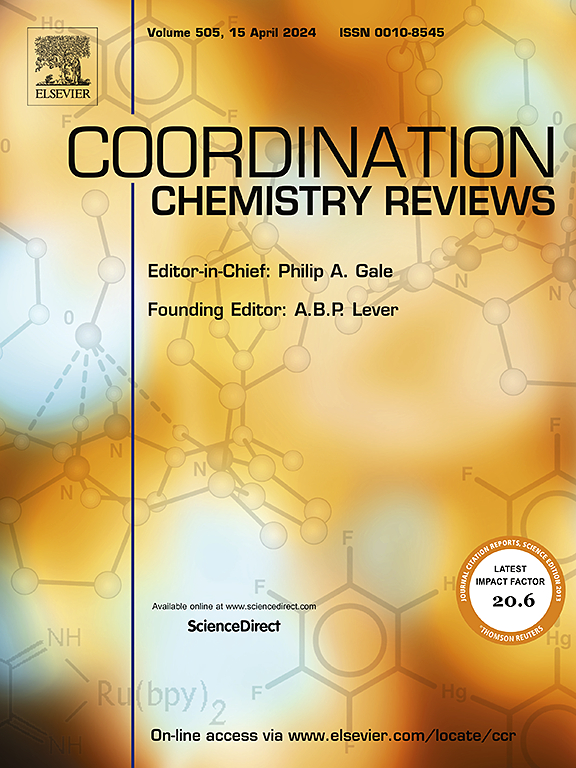Advances in ZIF-8 variants: Synthesis, design, and applications in gas sensing
IF 20.3
1区 化学
Q1 CHEMISTRY, INORGANIC & NUCLEAR
引用次数: 0
Abstract
Zeolitic imidazolate framework-8 (ZIF-8), a subgroup of metal-organic frameworks, has garnered significant focus due to its remarkable structural tunability, chemical stability, and high surface area. These attributes make ZIF-8 and its derivatives desirable materials for drug delivery, catalysis, absorption of different gases, and gas sensing applications. This review comprehensively explains the current advances in the synthesis of ZIF-8 and its derivatives, emphasizing the various approaches, including solvothermal, mechanochemical, sonochemical, and seed-assisted methods, etc. The influence of critical parameters like linkers, solvents, pH, temperature, reaction flow rate, viscosity, interfacial tension, and reaction conditions on the morphology and performance of ZIF-8 is systematically analyzed. Furthermore, it explores the roles of ZIF-8-based materials in electrochemical sensing, highlighting their performance in sensing gases such as CO2, NH3, H2S, volatile organic compounds, NO2, and H2. The mechanisms behind the sensing capabilities of pure, composite, and hybrid ZIF-8 are explained, emphasizing the structure-property relationship and the development of composites. Challenges such as reproducibility, scalability, and environmental stability are also addressed, alongside prospects for integrating ZIF-8 into next-generation gas sensors. This review provides insight into the synthesis-application nexus, aiming to guide future research towards the rational design of ZIF-8-based gas sensors with improved performance and practical utility.

ZIF-8变体的研究进展:合成、设计和在气体传感中的应用
分子筛咪唑酸盐骨架-8 (ZIF-8)是一类金属有机骨架,因其具有显著的结构可调性、化学稳定性和高表面积而备受关注。这些特性使ZIF-8及其衍生物成为药物输送、催化、吸收不同气体和气体传感应用的理想材料。本文综述了ZIF-8及其衍生物的合成方法,包括溶剂热法、机械化学法、声化学法和种子辅助法等。系统分析了连接剂、溶剂、pH、温度、反应流速、粘度、界面张力、反应条件等关键参数对ZIF-8形貌和性能的影响。此外,还探讨了zif -8基材料在电化学传感中的作用,重点介绍了它们在传感气体(如CO2、NH3、H2S、挥发性有机化合物、NO2和H2)中的性能。阐述了纯ZIF-8、复合ZIF-8和混合ZIF-8传感能力背后的机制,强调了结构-性能关系和复合材料的发展。此外,ZIF-8还解决了再现性、可扩展性和环境稳定性等挑战,以及将ZIF-8集成到下一代气体传感器中的前景。本文综述了合成与应用之间的联系,旨在指导未来的研究,合理设计基于zif -8的气体传感器,提高其性能和实用性。
本文章由计算机程序翻译,如有差异,请以英文原文为准。
求助全文
约1分钟内获得全文
求助全文
来源期刊

Coordination Chemistry Reviews
化学-无机化学与核化学
CiteScore
34.30
自引率
5.30%
发文量
457
审稿时长
54 days
期刊介绍:
Coordination Chemistry Reviews offers rapid publication of review articles on current and significant topics in coordination chemistry, encompassing organometallic, supramolecular, theoretical, and bioinorganic chemistry. It also covers catalysis, materials chemistry, and metal-organic frameworks from a coordination chemistry perspective. Reviews summarize recent developments or discuss specific techniques, welcoming contributions from both established and emerging researchers.
The journal releases special issues on timely subjects, including those featuring contributions from specific regions or conferences. Occasional full-length book articles are also featured. Additionally, special volumes cover annual reviews of main group chemistry, transition metal group chemistry, and organometallic chemistry. These comprehensive reviews are vital resources for those engaged in coordination chemistry, further establishing Coordination Chemistry Reviews as a hub for insightful surveys in inorganic and physical inorganic chemistry.
 求助内容:
求助内容: 应助结果提醒方式:
应助结果提醒方式:


